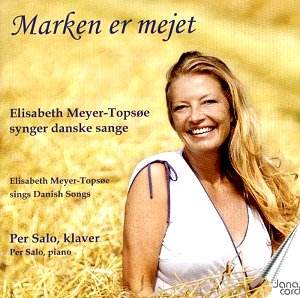A
number of these songs are the kind of
thing that Aksel Schiøtz used
to sing with such aplomb and conviction.
His voice was to the manner born when
it came to lyricism and sensitivity
and for a moment I thought that Elisabeth
Meyer-Topsøe’s might prove too
rich a soprano to do justice to these
essentially miniature settings.
The
programme is divided into seasons and
themes – Love and Longing occupies one
section as does The Country and its
history. Many are simple and reflective
and none, including the Nielsen settings,
stretch the boundaries too far. The
songs range in date from the 1790s to
about 1950, which is from J.A.P. Schultz
to Otto Mortensen, and often set the
superior lyrics of leading poets such
as Andersen, Oehlenschläger and
Jensen. But many took simpler and less
crafted lyrics, of which there are a
number here, and a fair few of the composers
are hardly household names either. So
there is real democracy at work in the
selection. The songs mirror contemporary
themes of course – whether in terms
of the revival of folk music or in increased
patriotism in the light of the threats
to Danish political and geographic independence.
Later still Nielsen and Laub tended
to strip away the late Romantic barnacles
and things became increasingly strophic.
We
all know what we do with the second
verse of an English folk song – sing
it louder than the first – but what
does one do with Danish folk songs?
Pretty much the same it seems. These
are lyrical generous hearted settings
without huge demands except on the apt
sustaining of mood and contrast, feeling
and intimacy, pacing and sense of line.
Meyer-Topsøe’s voice is a strong
instrument but it does well by the songs,
though it would be a heroic undertaking
to listen to the disc all the way through
without feeling a certain degree of
torpor (I’ve tried). One can enjoy the
bell chimes of Jeg er havren.
Jeg har bjælder på
and the simplicity of Septembers
Himmel er så blå. More
serious emotions are explored in a farewell
setting such as Oluf Ring’s Sig nærmer
tiden and the chill of Laub’s 1914
Det er hvidt herude. Listening
to Aagaard’s Spurven sidder stum
bag kvist put me in mind melodically
speaking of a rather more central European
scene, namely Good King Wenceslas as
he was looking out on the Feast of Stephen,
an occupation much indulged in that
neck of the woods. The Nielsen settings
are simple and charming – especially
the delightful Jeg bærer med
smil min byrde (1915) – but the
generally slow moving convoy of folk
material is spruced up by an allegretto-ish
1911 setting by Alfred Toft, Ole
sad på en knold og sang (Ole
sat singing on a knoll). There are some
hints of Schubert in Gade’s På
Sjølunds fagre sletter and
in the same section, The Country and
its History, Nielsen shows that patriotism
in musical terms need not equal bombast
(try Som en rejselysten flåde).
Elisabeth
Meyer-Topsøe has quite a big
voice, which she scales down well, and
prominent vibrato. Some may feel it’s
too big a voice for some of these settings
but I find it generally well deployed
and very convincingly musical. Pianist
Per Salo plays well – and relishes time
"off the leash" in the pianistic
setting Nu er dagen fuld af sang,
a Nielsen song that allows witty independence
to the piano line. The notes are good
and there are full texts in Danish and
English. Don’t do with this disc what
you do with a box of chocolates - a
few at a time is the healthier option.
Jonathan
Woolf
